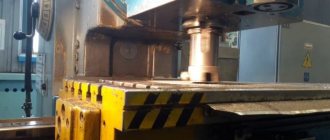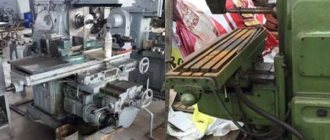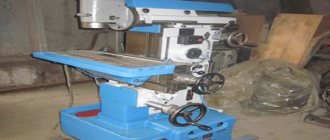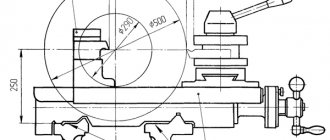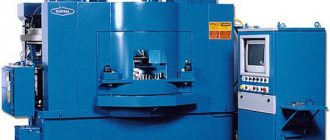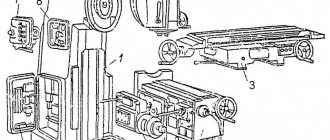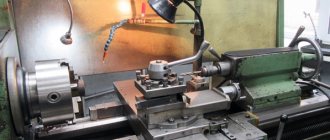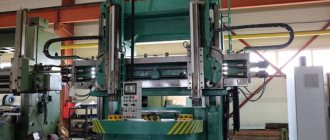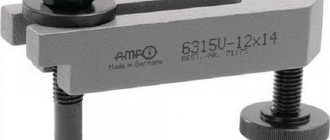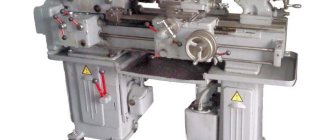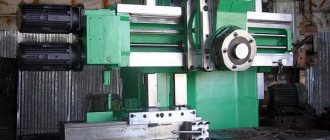Purpose and scope of application of the 6M13P cantilever milling machine
Using 6M13P equipment you can mill products made of cast iron, non-ferrous metals, and steel. In this case, face, cylindrical, end, and radius cutters are used.
With the help of such a tool, it is possible to process horizontal and vertical planes, grooves, corners, gears, corners, as well as bore holes, create spirals, and other parts that require periodic or continuous rotation around an axis during manufacturing. Successfully process parts on this machine using the high-speed milling method.
Carousel milling machine passport
Cheboksary Electromechanical College Technical operation and maintenance of electrical and electromechanical equipment (by industry) Course project in the discipline “MDK Planning at the Enterprise” On the topic “Rotary milling machine UFO803” Cheboksary 2015 The
2H135 drilling machine is designed for drilling blind and through holes in solid material, drilling, countersinking, reaming, cutting internal threads, cutting disks from sheet material. To perform such operations, drills, countersinks, reamers, taps and other tools are used. The forming movements when processing holes on drilling machines are the main rotational movement of the tool and the translational movement of the tool feed along its axis. Electrical equipment is powered with a variable frequency of 50 or 60 Hz. The control and lighting circuits are powered from the secondary windings of the supply transformers. − three-phase power circuit ∼(220) 380 (400); 415; (440)V - control circuits ∼110; (∼220)V - local lighting circuits (∼24);∼36V
Composition: Principal diagram, assembly diagram
Certificates for electrical equipment
- PASSPORTS for SCREW-CUTTING LATHES
- PASSPORTS for rotary lathes
- PASSPORTS for drilling machines
- PASSPORTS for boring machines
- PASSPORTS for Grinding machines.
- PASSPORTS for sharpening machines
- PASSPORTS for electroerosive, copying and piercing machines
- PASSPORTS for gear-threading machines
- PASSPORTS for Milling machines
- PASSPORTS for slotting machines
- PASSPORTS for planing machines
- PASSPORTS for Cutting machines
- PASSPORTS for hydraulic presses
- PASSPORTS for mechanical presses
- DATA SHEET for screw presses
- PASSPORTS for Guillotine shears. Leafy. Combined
- PASSPORTS for Hammer pneumatic
- Bending, Sheet bending, Profile bending, Pipe bending
- PASSPORTS for winding machines
- PASSPORTS for Other equipment
- PASSPORTS for welding equipment
- PASSPORTS for thermal equipment
- PASSPORTS for the Drive and other e.o.
- Machine repair manuals
PASSPORTS for Milling machines
The cost of completing the diagram in the “KOMPAS-3D V12” format is from 10 $ to 40 $
on the machine
This information is for informational purposes only, the model has been discontinued.
The 6A23 vertical rotary milling machine is designed for continuous milling of steel and cast iron parts with end mills in large-scale and mass production conditions
Design features
The design features are designed for high-quality milling work at high speeds and with parts made of high-strength materials.
Dimensions and dimensions of the working space
The dimensions and characteristics of the workspace allow processing large workpieces, which is convenient in industrial production conditions:
- Table dimensions – 40cmx160cm.
- The distance from the end of the spindle to the table is 3–50 cm.
- The parameters from the spindle axis to the vertical guides of the frame are 45 cm.
- The table travel lengthwise by hand is 80 cm.
- The table travel parameters across the hand are 32 cm.
- Vertical movement – 42 cm.
The height of the machine is 2235 mm, with a machine weight of 4150 kg.
Gearbox and spindle
The gearbox is located in the upper part of the frame and has a plug-in speed switching unit for control. This unit is located on the left side of the frame. To inspect and check the gearbox, there is a cover on the right side of the frame.
A spindle is mounted in the rotating head. The head itself is attached with four bolts directly to the annular recess of the neck of the bed. The swivel head can be rotated 45° from the vertical axis. To increase the rigidity parameters of the spindle during operation, there is a handle, the clamp of which tightens the body of the rotary head.
Spindle Specifications:
- rotation speed 31.5–1600 rpm;
- number of spindle speeds – 18;
- quill movement – 8.5 cm;
- movement of the quill by one division of the dial – 0.05 mm.
Location of controls
In total, the unit has 34 parts that are responsible for adjusting, configuring and controlling the main components. In addition to various handles, buttons and switches, there is also a clamping nut. All controls are mounted on the main body of the equipment; they help regulate and control the following processes:
- cooling;
- longitudinal movement of the table;
- spindle starting, braking and stopping;
- lubrication of the working surface;
- transverse and vertical movement of the working surface;
- spindle speed switching;
- limitation of the lateral movement of the work table;
- rotation of the milling head.
Feed mechanism
A separate 1.7 kW motor is mounted in the console of the unit. The feed drive comes from it. 18 feeds are carried out from the unit to the lead screws in the range of 25–1250 mm/min, the vertical movement screw is also carried out 10 feeds in the range of 8.3–450 mm/min. All nodes of the feed chain are located in the console. The electric motor transmits movement to the table, slide, and directly to the console.
Electrical diagram
Electrical equipment
The unit is powered from a three-phase network with a voltage of 380 V and a frequency of 50 Hz. All starting electrics are located in two niches of the frame. Each of them contains 2 panels, which have a common wiring diagram. In the left niche there is a door with an input switch handle for connecting electrical equipment to the network.
The electrical equipment of the 6M13P machine also includes:
- electric pump with switch;
- an electromagnet for driving the high-speed friction clutch and for disabling the feed dog clutch;
- reverse switch;
- input switch;
- spindle motor;
- feed motor.
The spindle engine is controlled by buttons.
Kinematic scheme
Data sheets for benchtop lathes
1d601
screw-cutting lathe: - djvu;
1.15 MB. Photo of machine 1D601
16u03p, 16u04p
screw-cutting lathe: - djvu;
1.5 MB. Photo of machine 16U03P
MK-3002
screw-cutting lathe: - djvu;
1.16 MB. Photo of machine MK-3002
T-65
screw-cutting lathe: - djvu;
0.66 MB. Photo of the T-65
TV-4
screw-cutting lathe: - djvu;
0.4 MB. Photo of the TV-4
TV-6
screw-cutting lathe: - djvu;
0.5 MB. Photo of TV-6
TV-7
screw-cutting lathe: - djvu;
1.45 MB. Photo of the TV-7
TV-7M
screw-cutting lathe: - djvu;
0.57 MB. Photo of TV-7M
TV-9
screw-cutting lathe: - pdf;
2.46 MB. Photo of the TV-9
TV-16
screw-cutting lathe: - djvu;
0.99 MB. Photo of the TV-16
TN-1
screw-cutting lathe: - pdf;
0.67 MB. Photo of the machine TN-1
Universal-2
screw-cutting lathe: - djvu;
1.2 MB. Photo of the machine Universal-2
Universal-3
screw-cutting lathe: - pdf;
2.1 MB. Photo of the machine Universal-3
Universal-V
screw-cutting lathe: - djvu;
2.2 MB. Photo of the machine Universal-B
Aiken MCJ-180/350-2
table lathe: - pdf;
1.0 MB. Photo of the Aiken MCJ-180/350-2
Jet BD-3
tabletop screw-cutting lathe: - pdf;
1.2 MB. Photo of the Jet BD-3
Jet BD-7
tabletop screw-cutting lathe: - pdf;
1.1 MB. Photo of the Jet BD-7
Jet BD-8A
tabletop screw-cutting lathe: - pdf;
0.6 MB. Photo of the Jet BD-8
Corvette-400
tabletop screw-cutting lathe: - pdf;
1.9 MB. Photo of the Corvette-400
Corvette-401
tabletop screw-cutting lathe: - pdf;
1.7 MB. Photo of the Corvette-401
Corvette-402
tabletop screw-cutting lathe: - pdf;
3.4 MB. Photo of the Corvette-402
Corvette-402
diagram and assembly details of a benchtop lathe, pdf;
2.1 MB. Photo of the Corvette-402
Corvette-403
tabletop screw-cutting lathe: - pdf;
4.7 MB. Photo of the Corvette-403
Corvette-403
diagram and assembly details of a tabletop lathe, pdf;
2.9 MB. Photo of the Corvette-403
Corvette-407
tabletop turning and milling machine: - pdf;
3.0 MB. Photo of the Corvette-407
Kraton MML-01
table lathe: - pdf;
5.0 MB. Photo of the machine Kraton MML-01
Specifications
The unit belongs to machines with increased precision of processing parts. Its main technical characteristics:
- milling spindle hole – 29 mm;
- milling spindle cone – No. 3 GOST 836-62;
- speed of rapid table movements across – 3 m/min;
- rapid longitudinal movements – 3m/min;
- vertical rapid movements – 1 m/min.
The machine is equipped with stops for longitudinal, transverse and vertical feeds, as well as blocking their separate activation and a safety clutch against overloads.
Design and performance characteristics
UV 320 involves the use of different types of cutters:
- End.
- End
- Cylindrical.
You can process:
- Cast iron.
- Steel.
- Non-ferrous metals.
- Plastics and more.
Use is possible in a wide variety of areas.
The design features of the machine are as follows:
- The maximum possible movement of the tabletop (mm): longitudinal – 900, vertical – 400, transverse – 320.
- The maximum possible angle of spindle movement: from the bed – 90, to the bed – 45, longitudinally – 45.
- The optimal possible movement of the spindle along the vertical plane is 80 mm.
- Number of steps: horizontal – 21, vertical – 12.
- Limit speeds: 45–2000, 20–2000 rpm.
- Number of table feeds: 12 mm/1600 min., vertically – 4.2 mm/533 min.
- The end of the spindle, according to GOST: horizontal. — 50, ver. – 40.
The dimensions of the entire machine are 2275 mm by 2240 mm by 2015 mm. Weight - 3250 kg.
Important!
Since the start of operation, the tactical and technical features are constantly deteriorating, which is also called natural wear and tear. Such complex products require standardization, therefore, from the moment the device is created, a set of operational and technical properties is distinguished, which includes testability, manufacturability, and more.
Operation and maintenance, passport
All machine parts can be replaced as they wear out, and therefore the unit itself does not have an exact service life. After a major overhaul, the unit completely restores its technical characteristics, accuracy and processing efficiency.
The surface on which this unit is installed must be perfectly flat. The best option is a concrete foundation with a thickness of at least 30 cm. During the initial start-up, it is necessary to fill the lubrication system reservoirs with oil and run the equipment at idle speed.
After about a week of operation, you need to carry out the first oil change. Then change the oil after a month, after which the change can be done regularly once every 3 months. It is necessary to switch modes and speeds only after the head has stopped.
The milling machine's passport can be downloaded for free from the link - Passport for a high-precision cantilever vertical milling machine.
Application and advantages of rotary turning machines
Using rotary lathes, they process large flywheels, gears and other similar parts. The technical capabilities of such devices allow the following technological operations:
- turning and boring of workpieces having a cylindrical and conical configuration;
- cutting ends and processing them;
- processing of inclined surfaces;
- formation of ring-type grooves on the surface of the part;
- drilling;
- deployment;
- countersinking.
Vertical turning lathes are also equipped with special devices, supplied separately, which allow the following operations to be performed on this equipment: milling, chiselling, cutting threads of various types, processing shaped surfaces using an electrocopier, grinding, processing workpieces using stops. The characteristics of rotary lathes make it possible to process workpieces made from ferrous and non-ferrous metals with a diameter of up to 25 m.
Single column machine 1516
The main movement in the machines of the group under consideration is performed by the work table (faceplate), on which the part is fixed. The feed movement, as in all lathes, is carried out by a support in rotary turning equipment.
Thanks to its design features, the rotary machine is characterized by high safety, reliability, ease of maintenance and operation. Among the most significant advantages of such equipment, the following are worth highlighting:
- accuracy and high quality of processing, requiring a minimum percentage of defects;
- ease of equipment control, which is especially typical for machine models equipped with a CNC system;
- high speed of all technological operations.
However, as many experts note, the most important advantages of rotary lathes include the safety of their operation.
Major faults and repairs
The main malfunctions include:
- Spindle slowdown. This is a sign of a short or obstruction in the circuit. You should use a multimeter to really assess the situation.
- The spindle does not rotate at all. The cause may be abnormal voltage, problems with the drive, or a loose screw on the connecting shaft.
It is also necessary to check the drive and replace it if necessary. Most components in the equipment are easily replaced if there is wear or breakdown.
Safety precautions
Almost all milling machines require similar safety regulations. Such equipment must not be approached while under the influence of alcohol or drugs; all clothing must be tucked in and buttoned up. In the work kit, the operator must have safety glasses that protect against chips getting into the eyes.
Foreign and domestic analogues
The main domestic analogues are vertical milling machines 6Р13 and 6Т13. They have lower performance in terms of processing accuracy, but in terms of technological operations they do not differ from the unit in question.
There are other analogues of the 6M13P unit:
- X5032, X5040 – similar machines made abroad (China).
- FV321M, (FV401) – Bulgarian units.
- FSS315, FSS350MR, (FSS450MR) - domestic products of the Gomel Machine Tool Plant.
Reviews
The 6M13P cantilever milling machine has many positive reviews. Users report precision processing when working with parts made from a wide variety of materials. The rigidity and reliability of the design, as well as high performance characteristics, make it possible to successfully use this equipment in small-scale and small-scale production. The unit is too large for home use.
More than half a century ago, the Gorky Milling Machine Plant began producing high-quality cantilever milling machines with increased processing accuracy and reliable design. This unit has proven itself in various industries and in small-scale production.
